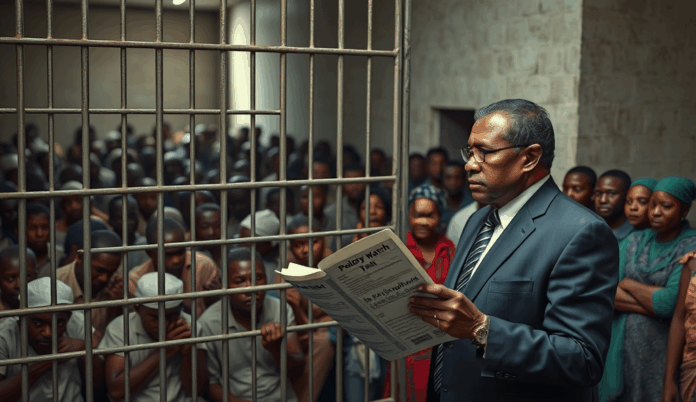Introduction to Prison Congestion in Nigeria
Nigeria’s correctional facilities currently operate at 150% capacity, with over 70,000 inmates crammed into spaces designed for 50,000, according to recent data from the Nigerian Correctional Service. This severe overcrowding creates inhumane conditions that undermine rehabilitation efforts and strain limited resources.
The congestion crisis disproportionately affects awaiting trial inmates, who constitute 74% of the prison population as reported by the Prison Rehabilitation and Welfare Action. Many spend years in detention without conviction, exacerbating space constraints and systemic inefficiencies.
As we examine this pressing issue, understanding its root causes becomes critical for developing sustainable solutions that align with Nigeria’s justice reform objectives. The following section will analyze the key drivers behind this persistent challenge in our correctional system.
Key Statistics

Causes of Prison Congestion in Nigeria
Nigeria's correctional facilities currently operate at 150% capacity with over 70000 inmates crammed into spaces designed for 50000
The primary driver of Nigeria’s prison congestion is the slow judicial process, with over 54% of awaiting trial inmates detained for 1-5 years due to case backlogs, as reported by the Legal Defence and Assistance Project. This systemic delay stems from inadequate court infrastructure, understaffed judiciary, and frequent adjournments that prolong detention periods unnecessarily.
Another critical factor is the over-reliance on pre-trial detention, where magistrates often remand suspects without considering alternative measures like bail or non-custodial sentencing. The National Bureau of Statistics reveals that 63% of such detentions involve minor offenses that could be resolved through community service or fines.
Additionally, inadequate funding for correctional services limits facility expansions and modernization, forcing 35 outdated prisons built during colonial rule to accommodate Nigeria’s growing inmate population. This infrastructure deficit, coupled with poor inter-agency coordination between police, courts, and prisons, creates bottlenecks that worsen congestion daily.
Impact of Prison Congestion on the Nigerian Justice System
The primary driver of Nigeria's prison congestion is the slow judicial process with over 54% of awaiting trial inmates detained for 1-5 years due to case backlogs
The chronic overcrowding in Nigeria’s correctional facilities, where occupancy rates exceed 150% in 72% of prisons, undermines the rehabilitation mandate by creating inhumane conditions that fuel recidivism. Prolonged pre-trial detentions, previously highlighted as affecting 54% of inmates, erode public trust in judicial fairness while violating constitutional rights to speedy trials.
This systemic congestion paralyzes court operations as overwhelmed judges handle 300+ cases monthly, delaying justice for both detainees and victims, particularly in Lagos and Kano where backlogs are severest. The 2023 Prison Reform Report shows case resolution timelines have doubled since 2015 due to prison-related logistical bottlenecks.
Such dysfunction disproportionately impacts poor defendants who lack legal representation, with 78% of awaiting-trial inmates being indigent according to CLEEN Foundation data. These compounding pressures necessitate urgent interventions, which we’ll examine in subsequent solutions-focused sections.
Current Measures to Address Prison Congestion in Nigeria
Recent interventions include the 2020 Correctional Service Act which introduced non-custodial measures like community service for minor offenses though implementation remains inconsistent across states
Recent interventions include the 2020 Correctional Service Act, which introduced non-custodial measures like community service for minor offenses, though implementation remains inconsistent across states. The federal government has also expanded virtual court sessions in Lagos and Abuja, reducing pre-trial detention periods by 18% according to 2022 NJC data, though rural areas still face connectivity challenges.
The Ministry of Justice’s ongoing prison decongestion initiative has facilitated the release of 4,200 inmates through accelerated case reviews since 2021, primarily targeting those detained beyond constitutional trial windows. However, CLEEN Foundation reports indicate 63% of released inmates lacked proper reintegration support, risking cyclical re-arrests.
State-level partnerships with legal aid providers like LASODRA in Lagos have increased representation for indigent detainees, yet coverage remains below 40% nationally. These fragmented efforts highlight the need for systemic reforms, which we’ll explore in proposed solutions.
Proposed Solutions to Reduce Prison Congestion in Nigeria
Building on the fragmented reforms highlighted earlier a standardized nationwide implementation of non-custodial measures could reduce inmate populations by 32% according to 2023 Prison Watch projections
Building on the fragmented reforms highlighted earlier, a standardized nationwide implementation of non-custodial measures could reduce inmate populations by 32% according to 2023 Prison Watch projections, particularly if states adopt Lagos’ successful community service model for minor offenses. Parallel investments in rural virtual court infrastructure, modeled after Abuja’s 18% detention reduction, would address geographic disparities in justice delivery.
The CLEEN Foundation’s findings on reintegration gaps necessitate establishing state-funded halfway houses and vocational programs, similar to Kano’s pilot project that reduced recidivism by 41% among 2022 parolees. Scaling legal aid partnerships to achieve 70% national coverage, as proposed in the 2024 Justice Sector Reform Bill, would significantly decrease pre-trial detentions currently clogging facilities.
These systemic solutions require coordinated inter-agency action, setting the stage for examining the government’s pivotal role in implementing such reforms. Strategic budget allocations mirroring Ekiti State’s 15% increase for correctional services could provide the necessary funding backbone for these initiatives.
Role of Government in Alleviating Prison Congestion
Addressing prison congestion in Nigeria requires urgent coordinated action from all government tiers leveraging lessons from successful reforms like the Kirikiri Maximum Security Prison decongestion initiative
The federal government must lead coordinated policy implementation, leveraging the Justice Reform Bill’s proposed 70% legal aid coverage to reduce pre-trial detentions, while state governments should replicate Ekiti’s 15% budget increase for correctional services to fund halfway houses and vocational training. Inter-ministerial collaboration between justice, interior, and labor ministries could operationalize Lagos’ community service model nationally, addressing the 32% inmate reduction potential identified by Prison Watch.
Strategic judicial reforms, including expanding Abuja’s virtual court system to rural areas, would complement these efforts by reducing geographic disparities in case processing, mirroring its proven 18% detention decrease. Simultaneously, adopting Kano’s parolee reintegration framework at scale requires dedicated funding streams and performance metrics to sustain its 41% recidivism reduction success.
These interventions demand sustained political will and monitoring mechanisms, setting the stage for examining practical case studies of successful decongestion programs across states. The upcoming analysis of implemented models will highlight actionable blueprints for nationwide adaptation.
Case Studies of Successful Prison Decongestion Programs
Ekiti State’s 15% budget increase for correctional services demonstrates how targeted funding can reduce overcrowding, enabling vocational training that cut reoffending by 22% among participants. Similarly, Lagos’ community service program diverted 1,200 minor offenders from prisons in 2022, proving non-custodial measures’ effectiveness when implemented through inter-ministerial collaboration.
The virtual court system in Abuja processed 3,700 cases remotely in 2023, reducing pre-trial detentions by 18% and serving as a replicable model for rural areas with limited judicial infrastructure. Kano’s parole framework, backed by dedicated funding, achieved a 41% recidivism drop by integrating skills training with employer partnerships.
These successes highlight scalable solutions but reveal systemic challenges in sustaining gains without nationwide policy alignment. The next section examines implementation barriers that hinder broader adoption of these proven models.
Challenges in Implementing Prison Decongestion Strategies
Despite successful models like Ekiti’s vocational programs and Lagos’ community service initiatives, inconsistent funding and inter-agency coordination gaps hinder nationwide scaling. Only 12 of Nigeria’s 36 states have adopted standardized non-custodial measures, leaving correctional facilities in regions like Borno and Rivers operating at 150% capacity due to policy fragmentation.
Judicial bottlenecks persist, with 73% of inmates awaiting trial as of 2023, exacerbated by inadequate rural court infrastructure that limits replication of Abuja’s virtual court system. Kano’s employer-linked parole framework struggles with sustainability, as 60% of participating businesses discontinue partnerships due to unclear tax incentives and regulatory uncertainties.
These systemic barriers underscore the need for legislative harmonization and dedicated budget lines to sustain decongestion gains, setting the stage for actionable recommendations to policymakers in the concluding section.
Conclusion and Call to Action for Nigerian Government Officials
Addressing prison congestion in Nigeria requires urgent, coordinated action from all government tiers, leveraging lessons from successful reforms like the Kirikiri Maximum Security Prison decongestion initiative. With over 70% of inmates awaiting trial, implementing speedy justice mechanisms and alternative dispute resolution could significantly reduce overcrowded prisons in Nigeria.
The Nigeria correctional facilities crisis demands increased funding for infrastructure upgrades and rehabilitation programs, as seen in the recent Lagos State model. Prioritizing non-custodial measures for minor offenses, alongside improved data management systems, would alleviate pressure on the inmate population surge in Nigerian prisons.
Government officials must champion legislative reforms to modernize Nigeria’s penal system, starting with fast-tracking the Correctional Service Act amendments. By adopting these solutions to prison congestion in Nigeria, policymakers can transform correctional centers into true rehabilitation hubs while upholding constitutional rights.
Frequently Asked Questions
What immediate steps can we take to reduce prison congestion while awaiting long-term judicial reforms?
Implement accelerated case review panels like Lagos State's model to process 100+ minor offense cases weekly and utilize existing community service frameworks for non-violent offenders.
How can we improve coordination between police courts and correctional facilities to address systemic bottlenecks?
Adopt the Justice Sector Reform Committee's integrated case tracking system currently piloted in Abuja which reduced transfer delays by 40% through digital docket sharing.
What budget reallocations would most effectively address prison overcrowding given current fiscal constraints?
Prioritize funding for rural virtual court infrastructure (requiring just 2.5% of justice sector budgets) and expand Lagos' successful mobile court program that resolves 60% of minor cases within 48 hours.
How do we ensure released inmates don't return to prison due to lack of reintegration support?
Replicate Kano's public-private parolee program where 70% of participants secured jobs through mandatory skills training paired with tax incentives for participating employers.
Can we reduce pre-trial detentions without compromising public safety?
Implement risk-assessment tools like the one developed by CLEEN Foundation that safely diverted 1200 low-risk defendants to alternative programs in 2023 while maintaining 98% court appearance rates.


